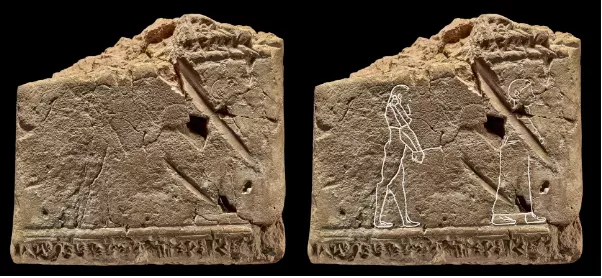A few days ago, a curator of a museum found the oldest ghost portrait on a 3500 year old ancient Babylonian stone slab, even with instructions on how to expel ghosts. The stone slab depicts a male ghost with an exposed temper and a beard who is pulled into the underworld by a woman with a rope. Beside the pattern, words are carved to explain that the way to eliminate the annoying male ghost is to give him a lover.

Irving Finkel, senior curator of the central and eastern part of the British Museum in London, found this interesting slate pattern when checking the inscriptions related to ghosts. Then he translated the words on the slate. It is reported that the British Museum obtained this stone slab in the 19th century, as well as thousands of stone slabs from Babylon, an ancient city about 100 kilometers south of Baghdad, Iraq. Understanding these stone slabs will help archaeologists gain insight into the living conditions of ancient residents in Babylon and Mesopotamia.
The tablet is not big, and people can hold it in one hand. At least the other half of the tablet is damaged. Finkel can recognize the cuneiform characters on the tablet. This is an ancient writing system from the Middle East, which depicts a ritual related to human ghosts. Before, he did not carefully observe this slate painting. Later, after careful observation, he found a beautiful picture that could hardly be seen by the naked eye, and identified the ghosts and women in the picture. He said: "the figure in the picture is as exciting as suddenly coming out of the myth. The picture should be a visual aid to some kind of exorcism ceremony. The ceremony is carried out by the Exorcist."
It is reported that the exorcism ceremony in the ancient Babylonian period was very special. The Exorcist would make a stone picture of a man and a woman for the ferry, and provide them with specific daily necessities, including travel supplies for men and household appliances for women. Then the stone picture would be buried at sunrise. At the same time, the Exorcist would recite the mantra. The mantra engraved on this stone was incomplete, It began with the summoning of the ancient Babylonian Sun God Shamash, who is the God responsible for transferring human ghosts to the underworld in myth.
Finkel said: "this is not a symbolic ceremony, but a rigid ceremony. The Exorcist wants to turn the ghost into an image on the stone, so that the dead can die under the blessing of the sun god Shamash. The last line of the exorcism ceremony warns: 'don't look back!', which may be issued when the human ghost enters the underworld."